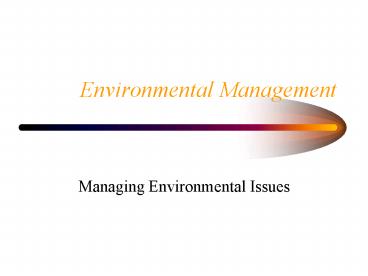Environmental Management PowerPoint PPT Presentation
1 / 13
Title: Environmental Management
1
Environmental Management
- Managing Environmental Issues
2
Sustainable Development
- Development that meets the needs of the present
without compromising the ability of future
generations to meet their own needs - Two core ideas
- poverty is an underlying cause of environmental
degradation - economic development must be accomplished
sustainably
3
Forces of Change
- Population explosion
- World poverty
- Industrialization
4
Leading US Environmental Protection Laws
- 1969 - National Environmental Policy Act
- 1970 - Clean Air Act
- 1972 - Water Pollution Control Act
- 1972 - Pesticide Control Act
- 1973 - Endangered Species Act
- 1974 - Safe Drinking Water Act
- 1974 - Hazardous Materials Transportation Act
5
Leading US Environmental Protection Laws
- 1976 - Resource Conservation and Recovery Act
- 1976 - Toxic Substances Control Act
- 1977 - Clean Air Act Amendments
- 1980 86 - Comprehensive Environmental
Response Compensation and Liability Act
(Superfund) - 1987 - Clean Water Act amendments
- 1990 - Clean Air Act
- 1990 - Pollution Prevention Act
6
Policy Approaches to Reducing Pollution
- Command and Control Strategies (environmental
standards) - Market Driven Strategies (market-based
mechanisms) - Information Disclosure Strategies
- Technology Forcing Strategies
7
Command and Control Strategies(Environmental
Standards)
- ADVANTAGES
- enforceable in the courts
- compliance mandatory
- DISADVANTAGES
- across the board standards not equally relevant
to all businesses - requires large regulatory apparatus
- older, less efficient plants may be forced to
close
8
Market Driven Strategies Tradable Allowances
- ADVANTAGES
- gives businesses more flexibility
- achieves goals at lower overall cost
- saves jobs by allowing some less efficient plants
to stay open - permits the govt. and private organizations to
buy allowances to take them off the market
- DISADVANTAGES
- gives business a license to pollute
- allowances are hard to set
- may cause regional imbalances in pollution levels
- enforcement is difficult
9
Market Driven Strategies Emissions Fees and
Taxes
- ADVANTAGES
- taxes bad behavior (pollution) rather than good
behavior (profits)
- DISADVANTAGES
- fees are hard to set
- taxes may be too low to curb pollution
10
Market Driven Strategies Government Incentives
- ADVANTAGES
- rewards environmentally responsible behavior
- encourages companies to exceed minimum standards
- DISADVANTAGES
- incentives may not be strong enough to curb
pollution
11
Information Disclosure Strategies
- ADVANTAGES
- government spends little on enforcement
- companies able to reduce pollution in the most
cost-effective way
- DISADVANTAGES
- does not motivate all companies
12
Technology Forcing Strategies
- ADVANTAGES
- companies change because it is in their best
interest - international cooperation is encouraged
- DISADVANTAGES
- relies on research grants to further technology
- must inform all businesses of newly developed
technology
13
Elements of Effective Environmental Management
- Top managers with commitment to sustainability
- Line manager involvement
- Codes of environmental conduct
- Cross-functional teams

